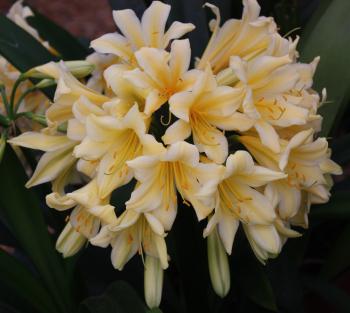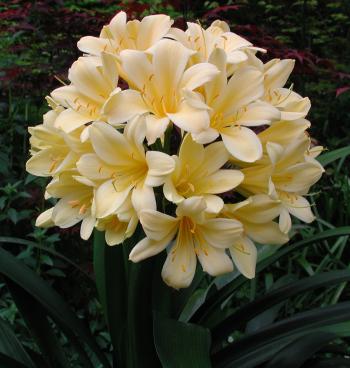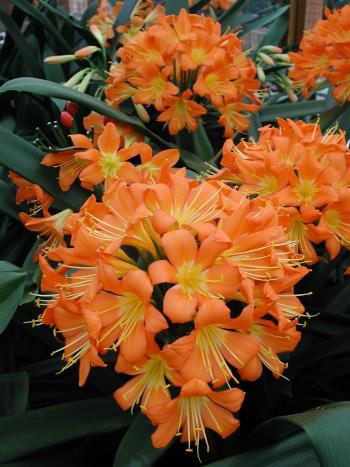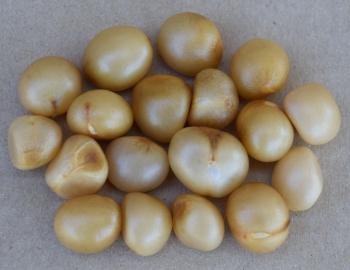Clivia miniata var. citrina
Clivia miniata (Lindl.) Regel var. citrina W.Watson
Family: Amaryllidaceae
Common names: yellow clivia, yellow bush lily (Eng.); geelboslelie (Afr.)
Introduction
Clivia miniata var. citrina is a horticulturally outstanding spring-flowering perennial, with a colourful history in cultivation. Grown worldwide for its striking cream-coloured or light to bright yellow umbels, it is a valuable, long-lived container and landscape subject for dappled shade.

Description
Description
This evergreen perennial reaches up to 0.8 m high in flower. It is generally classed as a bulbous plant and grows from a vertical, subterranean rhizome which sometimes extends above ground, with a thick mat of horizontally spreading, fleshy roots. The strap-shaped, arching leaves are light to deep green, arranged in 2 opposite rows (distichous) and sheathing at the base, forming a short pseudostem. The peduncle is laterally flattened with 2 sharp margins and emerges adjacent to the youngest leaves, towards the centre of the plant. The inflorescence is a 16–30-flowered umbel of moderately or widely funnel-shaped, cream-coloured or light to bright lemon-yellow flowers, sometimes with green-flushed throats. The flowers have short perianth tubes 7–10 mm long, broadly lance-shaped outer tepals, up to 60 mm long and spoon-shaped inner tepals, up to 65 mm long. The 6 stamens are slightly or strongly curved downwards and the ripe anthers have bright yellow pollen. The round or oblong ovary has a straight or slightly downwardly curved style, with 3 short, sticky stigmatic branches.

The ripe fruit is a round or egg-shaped, bright yellow or sometimes red-speckled berry containing 1, several or many, irregularly shaped, hard, light brown seeds, embedded in yellowish pulp. The basic chromosome number is x = 11.
Conservation Status
Status
According to the Red List of South African plants, consulted on 3 August 2017, this variety is assessed as Data Deficient (DD).
Distribution and habitat
Distribution description
Clivia miniata var. citrina is known from northeastern Mpumalanga, northern Swaziland, northern, central, eastern and southern KwaZulu-Natal and the eastern part of the Eastern Cape. It occurs as sporadic individuals within populations of mainly orange or red-flowered specimens (var. miniata), never as populations of exclusively yellow-flowered plants. Its habitat is coastal and inland afromontane forest, in ravines, along shaded watercourses and on rock ledges on south-, southeast- or rarely west-facing slopes, in decomposed leaf litter, between sandstone boulders and on dolerite soils, from close to sea level to 1 500 m altitude. This variety is suited to cultivation in dappled shade in frost-free environments.

Derivation of name and historical aspects
History
The genus Clivia honours Lady Charlotte Florentia Clive, Duchess of Northumberland, in whose conservatory the first described member of the genus, C. nobilis, flowered in the late 1820s at Syon House, along the Thames, near Kew. The specific name miniata is descriptive of the flame-scarlet tepal colour of the typical colour forms (var. miniata), and the varietal name citrina describes the lemon-yellow tepal colour of certain forms of this variety.
The earliest record of a yellow form of C. miniata from a known wild source, is that made in 1888 in a forest near Eshowe, in eastern KwaZulu-Natal. The resident commissioner of Zululand, Sir Melmoth Osborn, noticed it among firewood that had been collected by one of his staff, and he propagated it. Two plants were later obtained by his deputy, Sir Charles Saunders, who in turn sent one specimen to his artist mother Katharine Saunders some distance to the south, in Tongaat. Her painting, done from a somewhat bedraggled flower head that had spent several days in a post bag en route via ox-cart to Tongaat in October 1893, was eventually published in the book Flower paintings of Katharine Saunders, in 1979. A plant from this collection was sent to Kew and successfully grown there, and later described as C. miniata var. flava (a synonym of C. miniata var. citrina) by E.P. Phillips in 1931, in The Flowering Plants of South Africa, with a colour plate by Cythna Letty.
In 1897, a yellow-flowered plant collected at an unspecified locality in Zululand by Captain Mansell, flowered in cultivation in the garden of Mrs Powys Rogers in Cornwall, England. Two years later, another yellow-flowered specimen, earlier sent to Kew by the Rev. W.H. Bowden of North Devon from a different source in Zululand, flowered at Kew, and was noted in The Gardener’s Chronicle as C. miniata var. citrina, in 1899 by William Watson, then Assistant Curator of the gardens at Kew. Later that year he followed this with a detailed description in the journal The Garden, illustrated with a colour plate by the English botanical painter Henry Moon of the plant grown in Cornwall. Due to their rarity in cultivation, yellow forms have commanded high prices and long been regarded as family heirlooms, but are becoming more widely cultivated.
Numerous additional collections of C. miniata var. citrina have since been made in the wild, or arisen in cultivation (both in South Africa and abroad), and some of the more striking ones have received cultivar names. They are distinguished by various features, including flower head shape and size, flower orientation, flower shape, size and colour, presence or absence of a green throat, tepal shape and degree of overlapping, leaf width and colour, flowering period, and tendency to form suckers or not. In addition, certain cultivars are scented, such as ‘Kirstenbosch Yellow’ which has a sweet, azalea-like fragrance.

The yellow forms fall into two main classes; those that breed true to type when self-pollinated (selfed) are classed as ‘Group 1’ and those that do not, are classed as ‘Group 2’. Members of ‘Group 1’ have no trace of anthocyanin pigment in their flowers and fruits, and they breed true to type (such as ‘Kirstenbosch Yellow’) when selfed or crossed with other forms belonging to ‘Group 1’. Those belonging to ‘Group 2 ’, have minute traces of anthocyanin (pinkish-red) pigment streaks or spots in their flowers and fruits (such as ‘Natal Yellow’).

When a member belonging to ‘Group 2’ is crossed with another member of ‘Group 2’, the progeny is usually 100% yellow, such as the cross raised by the author, known as Pat’s Gold strain (‘Butter Yellow’ x ‘Natal Yellow’).

When a ‘Group 1’ plant is crossed with a ‘Group 2’ plant, the progeny is usually 100% orange, such as the cross raised by the author known as C. miniata Kirstenbosch Supreme strain (‘Kirstenbosch Yellow’ x ‘Natal Yellow’). When self-pollinated, the progeny of yellows belonging to ‘Group 2’ usually varies from 100% orange to 50% yellow, or a very low percentage of yellow, for example ‘Dwesa Yellow’ produces only a few yellows when selfed.

Yellow forms from known wild sources are recorded mainly from KwaZulu-Natal, including the following forms which have cultivar names (with ‘Group’ membership indicated, where known): ‘Blinkwater Yellow’ (Group 1), ‘Eshowe Yellow’ (Group 1), ‘Mare’s Yellow’ (Group 1), ‘Mvuma Yellow’, ‘Natal Yellow’ (Group 2), ‘Ndwedwe Alpha Thurston’ (Group 2), ‘Ndwedwe Beta Thurston’, ‘Oribi Gorge Yellow’ (Group 2) and ‘Whyte Yellow’ (Group 1). ‘Dwesa Yellow’ (Group 2) and ‘Kentani Yellow’ (Group 2) are from the Eastern Cape. Those originating from cultivated sources in South Africa, include ‘Butter Yellow’ (Group 2), ‘De Villiers Yellow’, ‘Kirstenbosch Yellow’ (Group 1), ‘Noyce’s Sunburst’ (Group 1), ‘Noyce’s Yellow’, ‘Watkins Golden Glow’ and ‘Watkins Yellow’.

Comprising 5 species [C. caulescens, C. gardenii (including C. robusta), C. miniata, C. mirabilis and C. nobilis], Clivia is endemic to South Africa and Swaziland. C. miniata has the widest distribution, occurring from northeastern Mpumalanga and northern Swaziland to the Eastern Cape, with a disjunct population in the southern Cape. Peach-flowered forms of this species belong to var. miniata. In parts of its range, C. miniata overlaps with the 3 tubular-flowered species from the summer rainfall area, C. caulescens, C. gardenii and C. nobilis. C. mirabilis, the only species from an exclusively winter rainfall area, is endemic to the Bokkeveld escarpment and to mountains near Vanrhynsdorp. Within the family Amaryllidaceae, Clivia falls within the tribe Haemantheae, whose members all produce fleshy berries, including Apodolirion, Cryptostephanus, Gethyllis, Haemanthus and Scadoxus. Clivia is most closely related to Cryptostephanus, a genus of 3 species mainly from East and southcentral Africa with somewhat similar roots, leaves, flower stems and fleshy berries, but whose flowers differ markedly in their smaller size and colour (white, brownish or purplish maroon) and in having a partially hidden, crown-like structure of narrow appendages. Cryptostephanus also differs in basic chromosome number (x = 12).
Ecology
Ecology
Clivia miniata var. citrina is an evergreen perennial adapted to warm, moist summers and cool, dry winters. The new leaves emerge in the centre of the plant in spring and early summer, adjacent to the flower head. The berries reach maturity within 9–12 months, by which time the outer fleshy covering has turned light to bright yellow. They remain on the plant for months after maturity, the outer layer eventually disintegrating and the seeds falling to the ground. Flowering takes place from August to November, with a peak in September and October, but sporadic blooms may appear at any time of year. The flowers of certain forms are partially self-fertile in cultivation, sometimes producing a few seeds per flower head, irrespective of visits by potential pollinators. Swallowtail butterflies consume the nectar of the reddish orange flowers of var. miniata in the wild and are their main pollinators, however, it is not known whether they also visit those of var. citrina. Honeybees have occasionally been seen to feed on the nectar and pollen of var. citrina in cultivation at Kirstenbosch National Botanical Garden.

Uses
Use
The var. citrina itself has no recorded traditional, economic or magical uses, but the roots, rhizome and leaves of the reddish orange forms (var. miniata) are widely used by indigenous peoples of southern Africa. In the Eastern Cape, the Xhosa use decoctions of the roots to treat urinary conditions and childlessness. It is also said to relieve pain, and leaf infusions are used as a cleansing agent. Decoctions of the whole plant (except the flowers), are used to ease and hasten childbirth, and preparations of the rhizome are used to treat snakebite and fevers.
In KwaZulu-Natal, the Zulu make an infusion of the whole plant to sprinkle over their yards to ward off evil, and also use the roots as a love-charm emetic. Numerous toxic alkaloids have been isolated in var. miniata, as well as in C. caulescens, C. gardenii and C. nobilis, and all parts of the plant should be regarded as poisonous. Both var. citrina and var. miniata are used worldwide as spring-flowering ornamentals.

Growing Clivia miniata var. citrina
Grow
Clivia miniata var. citrina is an outstanding subject for containers and garden beds, placed in filtered or indirect light in a protected environment away from strong wind. Excessive exposure to sun results in rapid and severe scorching of the leaves and flowers. Use a well-drained, well-aerated, slightly acid medium containing plenty of organic matter, such as leaf mould and well-rotted compost. Add finely milled bark to the medium for container-grown plants, to improve drainage. Place the plants such that the roots and only the very base of the pseudostem are just below soil level. The plants perform admirably in large terracotta and plastic pots, and in troughs and wine barrels. They are particularly decorative when grown as specimen plants in large pots flanking shady garden stairs or on either side of a shady front door. They are ideally suited to the cool glasshouse and can also be grown in the home, provided it is only minimally heated in winter. In the garden, the flowers of var. citrina are effectively contrasted when inter-planted with reddish orange forms of var. miniata that flower simultaneously. It is also an ideal companion plant for shade-loving ferns, asparagus, low-growing plectranthus and the nettle, Laportea grossa. Once established, allow the plants to remain undisturbed for at least 5 years before division, or until flowering performance diminishes.
Container-grown plants perform best when their roots are slightly constricted, provided they are well fertilized. They are gross feeders and a recommended granular fertilizer such as 3:1:5 applied in early spring, early summer and late autumn, suits them well. Alternatively, apply a slow-release fertilizer in early summer or early autumn, and a seaweed extract fertilizer when the buds form, to ensure longer flower stems. After flowering, the attractive evergreen leaves and ripening yellow ripe berries provide continued interest in the garden. For container-grown plants, water heavily once or twice per week from spring to late autumn, and for garden beds, about once per week. In winter, reduce watering to once or twice per month in summer rainfall areas, however, in winter rainfall parts, they easily survive heavy rainfall, provided the soil is sufficiently well drained. Given sufficient shade, the plants are remarkably waterwise. They are frost tender and in susceptible areas, cover with a frost blanket; in marginal areas they can be grown under overhanging eaves or evergreen trees that provide some protection.
Propagate by dividing thick clumps straight after flowering or by sowing seed from ripe yellow berries in spring. Remove old flower heads and the older, outer leaves from divided plants, but do not cut off the remaining ones, replant immediately and water well. Remove the seeds from the berries once they start to turn yellow by peeling away the fleshy outer layer. Press each seed into a seedling medium such as one part coarse river sand and three parts finely milled, composted pine bark or decomposed pine needles in a deep seed tray, such that each seed is partially exposed. Place seed trays in a fairly warm (15–21°C), shaded, well-aerated place under cover, and water thoroughly once or twice per week with a watering can fitted with a fine rose-cap. Germination usually takes place within 4–8 weeks, and once they are a year old, plant them individually into 15 cm diameter pots or 1 litre nursery bags. In the spring of their second year, plant them into 20 cm diameter pots or 3 litre bags and allow to grow for a further year before planting out into permanent positions. Seedlings benefit from weekly applications of high nitrogen liquid fertilizers and in ideal conditions, can flower in 3 years. Bear in mind that seeds harvested from yellow berries will only produce 100% yellow-flowered offspring if the adults are ‘Group 1’ individuals that have been selfed or crossed with other members of ‘Group 1’, or if they are ‘Group 2’ individuals that have been crossed with other ‘Group 2’ individuals. Seeds from yellow clivias that have been open-pollinated will usually only yield a very small percentage of yellow offspring. An easy way to determine whether seedlings will produce yellow flowers or not, is by examining the base of the leaves during the first or second year of growth: if they are plain green (unpigmented) they will produce yellow flowers, but if they are pigmented with reddish maroon, the flowers will be reddish orange.
The pseudostem, leaves, flower stems and flower stalks, are highly susceptible to attack by the lily borer caterpillar (Brithys crini), especially in summer, resulting in discolouration and collapse of the whole plant in severe infestations. The night-flying moth lays her eggs mainly on the undersides of leaves and are difficult to spot. Crush young larvae by hand as soon as possible, or cut off and destroy heavily infested leaves. The European brown garden snail (Cornu aspersa) relishes the buds and flowers, and the leaves to a lesser extent, and can transmit viral disease. The leaves often look unsightly due to small, nocturnal, grey snout beetles that chew the margins, and should be removed by hand using a bright torch. If kept too wet, the leaf bases and pseudostem may succumb to bacterial soft rot. Lift the plant immediately, remove the affected portions and wash with water, then apply a fungicide and replant in sterilized sand to encourage new growth.
References
- Bayer, A. 1979. Flower paintings of Katharine Saunders. The Tongaat Group Limited, Maidstone.
- Crouch, N.R., Mulholland, D.A., Pohl, T.L. & Ndlovu, E. 2003. The ethnobotany and chemistry of the genus Clivia (Amaryllidaceae). South African Journal of Botany 69: 144–147.
- Duncan, G.D. 1985. Notes on the genus Clivia Lindl. with particular reference to C. miniata Regel var. citrina Watson. Veld & Flora 71(3):84-85.
- Duncan, G.D. 1992. Notes on the genus Clivia Lindl. with particular reference to C. miniata Regel var. citrina Watson. Herbertia 48: 26–29.
- Duncan, G.D. 2008. Grow clivias. Kirstenbosch Gardening Series. South African National Biodiversity Institute, Cape Town.
- Duncan, G.D. 2016a. A historical synopsis of the genus Clivia Lindl., and a remarkable range extension for Clivia miniata var. miniata in the Cape Floristic Region, South Africa. Curtis’s Botanical Magazine 33(2): 169–189.
- Duncan, G.D. 2016b. The Amaryllidaceae of southern Africa. Umdaus Press, Pretoria.
- Morris, W. 1999. Classification of the known varieties of yellow clivia. Clivia Club Newsletter 8(1): 10–13.
- Phillips, E.P. 1921. Clivia miniata var. flava. The Flowering Plants of South Africa 11: t. 411.
- Snijman, D.A. 2002. A remarkable new discovery in Clivia. Herbertia 57: 35–40.
- Watson, W. 1899a. Kew notes. The Gardener’s Chronicle (series 3) 25: 228.
- Watson, W. 1899b. Clivia miniata citrina. The Garden 56: 338, 339.
Credits
Graham Duncan
Kirstenbosch National Botanical Garden
October 2017
Plant Attributes:
Plant Type: Bulb
SA Distribution: Eastern Cape, KwaZulu-Natal, Mpumalanga
Soil type: Loam
Flowering season: Spring, Early Summer, Sporadic/All year
PH: Acid, Neutral
Flower colour: Cream, Yellow
Aspect: Shade, Morning Sun (Semi Shade)
Gardening skill: Easy
Special Features:
Horticultural zones











Rate this article
Article well written and informative
Rate this plant
Is this an interesting plant?
Login to add your Comment
Back to topNot registered yet? Click here to register.